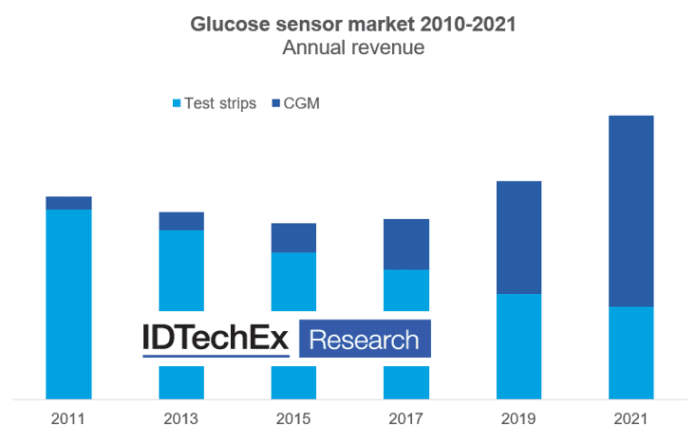

Glucose monitoring is an integral part of diabetes management, and test strips have historically been the predominant method of measuring blood glucose. However, continuous glucose monitors (CGMs) have emerged as a major competitor over the last decade; the CGM market has seen major growth over the last few years and is predicted to drive further declines in the test strip market. By 2032, IDTechEx predicts the test strip industry to make up only 6.7% of the overall diabetes management device market, down from a peak of 63.4% in 2010.

Test strips have been in decline, while CGMs maintain steady growth. Source: IDTechEx – “Diabetes Management Technologies 2022-2032: Markets, Players, and Forecasts“
There have been many factors contributing to this rapid growth of CGMs, with improved quality of data and patient comfort being just a few examples. The IDTechEx report “Diabetes Management Technologies 2022-2032: Markets, Players, and Forecasts” answers questions on how large this market will be by 2032 and what consequences it will have on the diabetes digital health industry.
Why CGMs are important for diabetes digital health platforms
CGMs offer several improvements over test strips; of note is the better data quality CGMs can offer. A high reading frequency allows for historical trends of blood glucose to be identified, in addition to the readings themselves. This, in turn, greatly expands the possible functionality of diabetes digital health platforms. An example would be the integration of machine learning algorithms to predict fluctuations in blood glucose based on this data, as is done by Bioconscious; this would be otherwise impossible with test strips due to the lack of data. By increasing the amount of historical blood glucose data available, patient habits could also be identified. This could be used in telehealth platforms for healthcare experts to identify patient behavioral habits and thus provide tailored advice accordingly to improve patient outcomes.
The increasing connectivity of CGMs is also beneficial for digital health integration. Newer CGMs can connect directly to mobile devices and transmit data automatically without patient input; these CGMs tend to ship with a native smartphone app, allowing patients to check their blood glucose data directly from their phone. This has laid the groundwork for creating smartphone applications that can directly obtain data from CGMs, thus allowing digital health platforms that can obtain the required data directly without human intervention. As an example, CGM manufacturer Dexcom has created a set of APIs and modules that allow third-party software to obtain data from Dexcom CGMs. The convenience of such a system would thus encourage patient adoption.
CGMs can offer much to digital health platforms, but the converse is also true. Digital health platforms offer CGMs the possibility for expansion into large untapped type 2 and prediabetes markets. Despite forming almost 95% of the total diabetes patient population, type 2 patients do not tend to use CGMs due to the high cost and lower need for improved data quality. Thus, expanding the services CGMs can offer via digital health integration may provide type 2 and prediabetes users with further incentive to adopt these devices. This possibility of expanding their reach into type 2 and prediabetes markets may see CGMs push for partnerships with digital health platforms, thus further encouraging the growth of the digital health industry.
However, there may be a potential competitor to current market CGMs for prediabetes and type 2 patients. Noninvasive glucose monitors have long been a subject of interest for the glucose monitoring industry, with some touting them as the “holy grail” of glucose monitoring. Even with their minimally invasive nature, CGMs can still result in skin irritation due to their form factors; this problem would not be present with noninvasive glucose monitors. Several companies developing noninvasive monitors have also stated expectations that their devices would be cheaper than all other current market CGMs, further encouraging patient adoption. Furthermore, the lower accuracy experienced by many noninvasive monitors would be less of an issue as prediabetes requires less stringent glucose control. All of these may suggest noninvasive monitors would be the ideal option for type 2 and prediabetes, but expectations must also be tempered. Despite years of research by hundreds of companies, few noninvasive devices have ever come to market, and only one known device has ever achieved FDA approval. Even this device was pulled from the market due to issues with skin irritation and poor accuracy.
While CGMs may be a significant driver for digital health, this is far from the only industry expected to see major effects from the growing CGM industry. IDTechEx predicts large shifts in the diabetes management device industry over the next 10 years, with the overall industry expected to reach $28.9 bn in 2032. In the report “Diabetes Management Technologies 2022-2032: Markets, Players, and Forecasts“, IDTechEx explore the outlook for various markets across the entire industry and how they will evolve over the next 10 years. About IDTechEx IDTechEx guides your strategic business decisions through its Research, Subscription and Consultancy products, helping you profit from emerging technologies. For more information, contact research@IDTechEx.com or visit www.IDTechEx.com.

Help keep news FREE for our readers
Supporting your local community newspaper/online news outlet is crucial now more than ever. If you believe in independent journalism, then consider making a valuable contribution by making a one-time or monthly donation. We operate in rural areas where providing unbiased news can be challenging. Read More About Supporting The West Wales Chronicle























